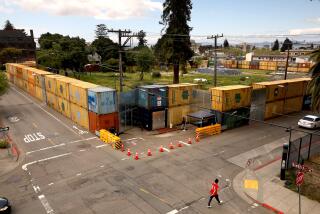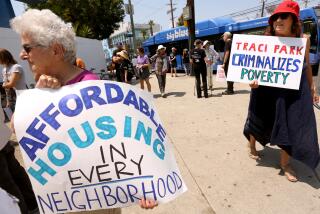Editorial: Using Californiaâs signature environmental law to shut down homeless housing is NIMBYism at its worst
Los Angeles is a city with 34,000 homeless people desperate for housing. But even when thereâs a developer and available land and money, getting the necessary housing built still requires wooing nervous politicians and skeptical neighbors.
The respected nonprofit developer and service provider A Community of Friends, which proposed the embattled Lorena Plaza project in Boyle Heights, knows all about that. After years of hearings and meetings, the project, which would be built on a vacant corner lot and offer two dozen of its 49 units to mentally ill homeless veterans, has won support from the local neighborhood council, the Los Angeles Chamber of Commerce and, finally, the local City Council member, Jose Huizar.
But it continues to be opposed by its would-be neighbor, El Mercado, the popular 50-year-old restaurant and shopping center down the street. Members of the Rosado family, which owns El Mercado, have testified against bringing mentally ill people to live so close by, appealed the projectâs environmental report, offered the developer another piece of land outside the city to build on, and â after all those strategies failed â have now filed a lawsuit claiming that the city of L.A. violated the California Environmental Quality Act when it approved an environmental report prepared for the city by consultants.
CEQA is too often used as a tool to slow down projects that communities donât like for NIMBY reasons.
A judge must now decide whether the environmental report sufficiently addressed the handling of potential contaminants under the soil â the possible remains of an abandoned oil well â or whether the city should have ordered a full-blown environmental impact report, as Tony Rosado and his family contend in their lawsuit.
But is this really a legitimate dispute over an oil well â or is it merely another way the Rosados have found to fight the homeless housing project they have long opposed? Does it raise real contamination-related issues, or is it merely the latest in a long line of frivolous lawsuits brought on environmental pretexts under CEQA?
At issue in the lawsuit is an abandoned oil well under the project site that, documents show, was drilled in 1949 and closed down three months later â probably because it never produced much oil. Itâs hardly unusual to find oil wells under the ground in Los Angeles. There are 3,133 that are plugged and abandoned underground and another 930 that were buried idle. Projects can be built safely, following city and state guidelines, on sites above properly abandoned oil wells, according to city officials.
In fact, experts have already done extensive environmental assessment of the property. First, consultants for the developer did an initial environmental site assessment, and later, another group of consultants prepared a 189-page report known as a âmitigated negative declarationâ â which found no evidence of significant hazardous contamination from the well. That report, done under the direction of the City Planning Department, noted that even if small amounts of contaminated soil are found, they can be easily mitigated â or cleaned up â before construction, without any risk to people. Another expert peer-reviewed the findings and concluded that there was no substantial evidence that the site contained any significant amount of contaminated soil.
The report was then approved by the City Planning Department and eventually approved by the City Council.
However, none of this has satisfied the El Mercado owners, whose lawsuit contends that their expert believes the study is insufficient and that the developers should do a full environmental report to address the impact of significant air and soil hazards that may exist. The suit also raises concerns about contamination from a once-existing lumber yard, even though the consultants on the project found no potential hazards there either.
Of course, itâs important to study the environmental impact of a building project. And the nearly five-decade old CEQA law often helps do so. But these days, CEQA is too often used as a tool to slow down projects that communities donât like for NIMBY reasons or that a company doesnât like because it feels the project will harm its bottom line. Under CEQA, itâs relatively easy to mount a successful challenge to a developerâs mitigated negative declaration â too easy, in the view of many lawyers.
Are the Rosados sincere in their concern for the environment? Itâs hard to know, although Dora Gallo, the chief executive of A Community of Friends, says that Tony Rosado offered to drop his opposition if she dropped her plan to house mentally ill people in the new building. (Gee, what about the oil well?)
Rosado says he never promised to drop the environmental issues. But in an email to The Times, he said that housing people with serious psychological issues ânext to a high traffic business and cultural center like El Mercado is not taking into consideration the compatibility of the new project with the existing character of the neighborhood.â Thatâs classic NIMBYism, not environmentalism.
Follow the Opinion section on Twitter @latimesopinion or Facebook
More to Read
A cure for the common opinion
Get thought-provoking perspectives with our weekly newsletter.
You may occasionally receive promotional content from the Los Angeles Times.










